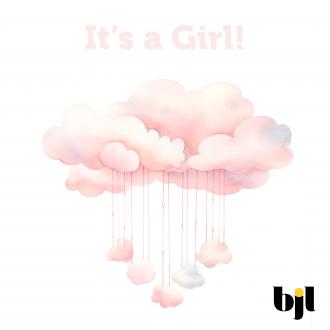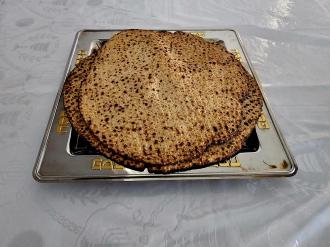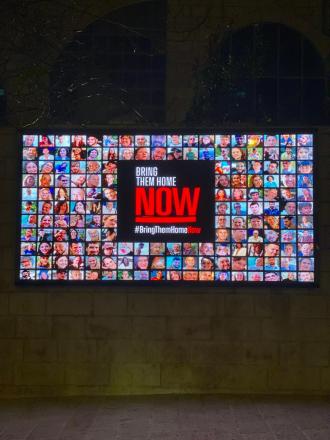The expansive universe is simply a physical expression of all that is embodied in the spiritual Mishkan. The Mishkan and all its elevated meaning and significance is merely a pale reflection of the powerful soul that is embodied in that remarkable entity called Man. (Zohar)
The various natural elements employed in the construction of the Mishkan symbolized the profound intellectual strengths, emotional expressiveness, and character traits that comprise man, the essence of all creation in its magnificence.
There was one item utilized in the fashioning of this microcosm that was associated with joy.
Atop the Mishkan lay a multi-colored hide stripped from a mysterious creature known as the Tachash. We are taught that this ‘beast’ only existed, לשעה, at that time. Rashi enlightens us by revealing that although we cannot identify this animal today, the Targum describes its nature as ססגונא, a contraction of the sentiment,ששֹשֹ ומתפאר בגוונין שלו, because it rejoices and prides itself in its hues.
Why is this detail regarding an animal’s apparent boasting of its colors relevant to this top layer of the Mishkan and its reflection on man?
The first Rebbe of Modzhitz, the Divrei Yisroel, wonders who actually merited to donate these hides. Clearly they weren’t stockpiled or confiscated from the Egyptians since this creature only appeared for the purpose of constructing the Mishkan. He conjectures that it was those poor individuals who never, דחקו את השעה, pushed their way in seizing and accumulating wealth, who lived in the ‘moment’, content with their lot, to whom Hashem providentially directed these animals, so they may merit donating them.
The nature of this remarkable creation was that it ‘thrilled in its colors’, whether the dark times or the bright times, or the gray shades in between, it was happy with its lot.
The brother of the Maharal, in Iggeres HaTiyul, suggests that the quality to be happy with whatever situation one finds oneself, as expressed in Pirkei Avos as השמח בחלקו, alludes to this ‘colorful’ adaptation.
חֶ-לְ-ק-וֹ, his lot, stands for: חם, לח, קר, ויבש - hot, wet, cold and dry!
The Rebbe avers that when Rashi states that the Tachash appeared 'לשעה', it means that Hashem privileged those who happily lived ‘in the moment’ to associate with this symbol of the essence of joy.
The prophet Yechezkel foretells how in the future Hashem will shod us with Tachash hide, that we will wear upon our feet as we ascend in our pilgrimage to the Mikdash.
(יחזקאל טז י, תרגום שה"ש ז ב)
The Rebbe Reb Zushe was so impoverished that there were times he literally went shoeless. His disciples once asked him, “Rebbe, the Gemara states that when one dons his shoes one recites the blessing of שעשה לי כל צרכי, Who has provided me all my needs, but you who have no shoes, how will you bless the Creator?”
He lovingly gazed into the eyes of his followers and asked, “Have you ever wondered why of all our garments it is precisely on the shoes that we thank Hashem for ‘all our needs’?
“When it comes to all other garments one can often adapt someone else’s dress, shirt or suit to fit by tailoring it. The only articles of clothing that fits uniquely to its owner, are their shoes. One doesn’t taper another’s shoe to suit one’s foot.
“When we express our heartfelt thanks to Hashem for His so lovingly providing all our needs, it’s never about the shoes. It is about our unique station in life, that is represented by the shoes that only fit ‘me’. It is more about our specific circumstances that are precisely devised so that we may thrive as no other can.
“I thank Hashem for giving me everything I need, even if I lack shoes!”
In the story of Purim, Mordechai and Esther’s lives are suddenly and traumatically disrupted. Mordechai must now engage in political intrigue and the anxiety over Esther, his beloved niece’s and wife’s fate, as well as the destiny of the nation. Esther a righteous woman of valor must now live as the queen in the arms of the ignoble gentile and buffoon, Achashveirosh.
Yet they maintained their dignity, their sense of mission and certainly exclaimed with gusto each day and with joy, their praise to Hashem that ‘provides them with their every need’!
No wonder it is this holiday more than others we celebrate so joyously.
Yechezkel the Prophet reveals that when we stride with joy, even though we may walk ‘barefoot’, in our proverbial shoes fashioned from the skin of the Tachash, rejoicing over whatever hue we of life we find ourselves in, is the day the redemption will arrive.
Might the title for this animal the תַּחַשׁ, be an acronym for the sentiment - תָּמִיד חַיָיב שִֹמְחָה ?
May we each dance with joy in this month of Adar singing out loud praise to Hashem for providing us exactly what we each need!
באהבה
צבי יהודה טייכמאן

















